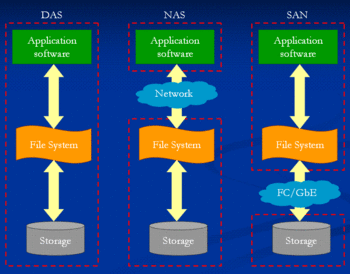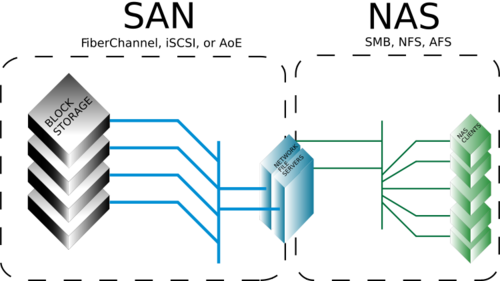Storage Area Network
Definition
1. A network whose primary purpose is the transfer of data between computer systems and storage elements and among storage elements.
A SAN consists of a communication infrastructure, which provides physical connections, and a management layer, which organizes the connections, storage elements, and computer systems so that data transfer is secure and robust. The term SAN is usually (but not necessarily) identified with block I/O services rather than file access services.
2. A storage system consisting of storage elements, storage devices, computer systems, and/or appliances, plus all control software, communicating over a network.
The SNIA definition specifically does not identify the term SAN with Fibre Channel technology. When the term SAN is used in connection with Fibre Channel technology, use of a qualified phrase such as "Fibre Channel SAN" is encouraged. According to this definition, an Ethernet-based network whose primary purpose is to provide access to storage elements would be considered a SAN. SANs are sometimes also used for system interconnection in clusters.
- definition source Storage Networking Industry Association (SNIA) definition
- SNIA's] full definition of a SAN
See also
Network Attached Storage (NAS)
Differences between a SAN and a NAS
- A NAS is defined by SNIA as
- systems that provide file services to host computers using file access protocols
- A SAN is is defined by SNIA as
- The term SAN is usually (but not necessarily) identified with block I/O services rather than file access services.
Conclusion
- A NAS can always be called a SAN
- A SAN can not necessarily be called a NAS unless it offers File Services via a network.
A NAS using a SAN backend
It is possible for a NAS to use a SAN backend as displayed in picture 2.
Additional reading
 IP Storage White Paper by SNIA
IP Storage White Paper by SNIA Storage Network Security by SNIA
Storage Network Security by SNIA Storage virtualization by SNIA
Storage virtualization by SNIA- SNIA education WEB. Lots of god stuff
VSAN - Virtual SAN
IVR - Inter VSAN Routing - også kendt som Fabric Routing giver forbindelse mellem Fabrics uden at sammenkoble dem direkte.
- Giver separation mellem Fabrics hvis der sker fejl i den lokale SAN
- Kan dele data mellem tusindvis af enheder
- Deling af centrale enheder mellem flere SAN's (Backup centralt af flere SAN's)
- Enheder i flere VSAN's kan kommunikere
- Replikering af data mellem VSAN's. (Reducere trafik lokalt)
FSPF - Fabric Shortest Path First
- Path-selection Protokol anvendt af FC (Fibre Channel) - Som OSPF
FSPF supporterer
- Multipath Routing
- Anvender Dijkstra algoritmen (Som OSPF)
- Dijkstra kører pr VSAN. (Som OSPF pr AREA)
Zoning
Zoning anvendes til at kontrollere forbindelse mellem Initiator og Storage Targets. Anvendes til at lave Access Control. Anvendes i et SAN eller et VSAN til at sikre hvilke enheder der kan se hvilke enheder.
FICON
Fber Connectivity er en OSI øvrelag protokol udviklet af IBM og anvendes til at sammenkoble IBM mainframes med Control Units (Storage). FICON afløser den lidt ældre ESCON og har følgende fordele.
- Kører på gigabit Fibre Channel
- Protokollen har bedre flowcontrol end ESCON og kan anvendes over store fysiske afstande.
- Op til 100 Km før der mærkes nedgang i performance mellem enhederne.
SANTap
SANTap er en facilitet der er supporteret på Cisco Storage Services Module (SSM) på MDS9500 og MDS9200 serie Fabric Directors. SANTap har følgende faciliteter
- Tillader transparent duplikering af data i Switch fabric.
- Kan for eksempel anvendes til samtidig backup





